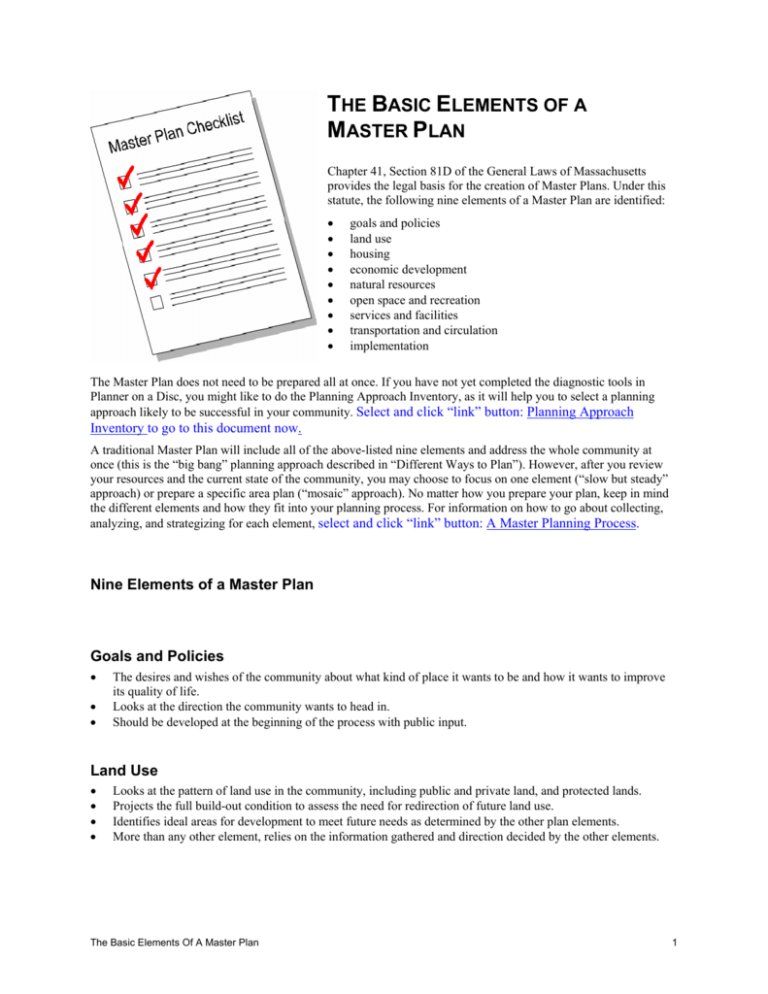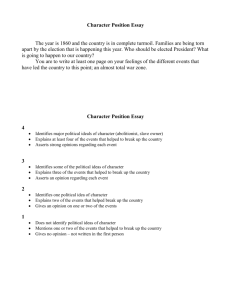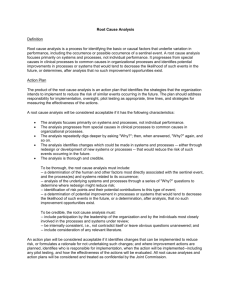The Basic Elements of a Master Plan
advertisement

THE BASIC ELEMENTS OF A MASTER PLAN Chapter 41, Section 81D of the General Laws of Massachusetts provides the legal basis for the creation of Master Plans. Under this statute, the following nine elements of a Master Plan are identified: • • • • • • • • • goals and policies land use housing economic development natural resources open space and recreation services and facilities transportation and circulation implementation The Master Plan does not need to be prepared all at once. If you have not yet completed the diagnostic tools in Planner on a Disc, you might like to do the Planning Approach Inventory, as it will help you to select a planning approach likely to be successful in your community. Select and click “link” button: Planning Approach Inventory to go to this document now. A traditional Master Plan will include all of the above-listed nine elements and address the whole community at once (this is the “big bang” planning approach described in “Different Ways to Plan”). However, after you review your resources and the current state of the community, you may choose to focus on one element (“slow but steady” approach) or prepare a specific area plan (“mosaic” approach). No matter how you prepare your plan, keep in mind the different elements and how they fit into your planning process. For information on how to go about collecting, analyzing, and strategizing for each element, select and click “link” button: A Master Planning Process. Nine Elements of a Master Plan Goals and Policies • • • The desires and wishes of the community about what kind of place it wants to be and how it wants to improve its quality of life. Looks at the direction the community wants to head in. Should be developed at the beginning of the process with public input. Land Use • • • • Looks at the pattern of land use in the community, including public and private land, and protected lands. Projects the full build-out condition to assess the need for redirection of future land use. Identifies ideal areas for development to meet future needs as determined by the other plan elements. More than any other element, relies on the information gathered and direction decided by the other elements. The Basic Elements Of A Master Plan 1 Housing • • Considers the pattern of residential development in determining what types of housing stock is needed and where it might best be constructed in the future. Assesses the local and regional area to determine how future market forces may influence the development and affordability of housing in the community. Economic Development • • Determines the strengths and weaknesses of the labor force and market sectors in the local economy in planning for new business and development. Looks at other businesses and industry location factors in identifying improvements to be made to stimulate desired economic development. Natural Resources • • Identifies land and water resources and cultural and historic resources whose preservation is important in maintaining natural resources and the character of the community. Develop strategies to protect and manage the natural and historic resources that enhance the attractiveness of the town. Open Space and Recreation • • Assesses the future recreational needs of the community in planning for the maintenance and expansion of existing areas, and the construction of new facilities. Recommends techniques to better protect and manage the current open space network and identifies future land acquisitions to meet active and passive recreational demand. Service and Facilities • • • Identifies the availability and status of public services, including education, public safety, water and sewer, energy, and other utilities. Looks at future growth and calculates the increased need for the provision of municipal services and facilities in planning for their expansion. Investigates the current delivery of municipal services and identifies best management practices and costefficient techniques to be implemented. Transportation and Circulation • • Identifies existing and potential roadway problems by looking at circulation and parking patterns, developing strategies for improvement. Identifies available alternative transportation options and considers how their future development may help alleviate congestion. Implementation • 2 Suggests strategies to be accomplished by the town to achieve the goals the community set forth at the beginning of the planning process taking into consideration what the community has and what it desires. Planner On A Disk • • Describes available funding sources and technical assistance to help the community put parts of the plan into practice. May include recommendations for zoning amendments, identification of responsible parties (including different municipal boards or departments), and priorities. Other Elements Any additional elements that require review and analyses in your community may be added to your Master Plan. Possible Changes to the Nine Elements The proposed Massachusetts Sustainable Development Act would require local comprehensive plans to have 10 elements, as described below. Although this legislation has not been approved as of this writing, it provides a very up-to-date and comprehensive list of required Master Plan elements, which may well become state law. Note that the principal difference in required elements between the existing state law, Chapter 41, and the proposed Sustainable Development Act is the addition of a watershed protection element. The Sustainable Development Act provides detail in describing the contents of each element. The 10 required elements are: 1. Goals and policies statement that identifies the goals and policies of the municipality to protect its natural resources and to provide for its growth and development. This element involves conducting an open, broadly participatory, and interactive process to determine municipal values and goals and to identify patterns of development that will be consistent with these goals. 2. Land use plan element, including a land use plan map illustrating present land uses and designating the proposed distribution, location, and interrelationship of public and private land uses. 3. Natural and cultural resources element that provides an inventory of the significant natural, cultural, and historic resource areas of the municipality as well as policies and strategies for protecting and managing such areas. 4. Watershed protection element that identifies water resources contained in whole or in part within a municipality, including resources and problems relating to water supply, wildlife habitat, and the impact of development activities on these watershed resources. 5. Housing element that identifies and analyzes existing and forecasted housing needs and objectives including programs for the preservation, improvement, and development of housing, including affordable housing. 6. Economic development element that identifies policies and strategies for expanding or stabilizing the local economic base and promoting employment opportunities. 7. Open space and recreation element that provides an inventory of recreational resources and open space areas of the municipality, plus policies and strategies for the management and protection of such resources and areas. 8. Services and facilities element that identifies and analyzes existing and forecasted needs for facilities and services used by the public, including, but not limited to those related to education, public safety, water and sewer services, and other utilities. 9. Transportation element that identifies existing and proposed intermodal transportation systems including roads, mass transit, pedestrian, bicycle, and waterways, as well as the effects of such systems on land uses within the municipality. 10. Implementation program element that defines and schedules the specific municipal actions, including the identification of the anticipated costs and revenues associated with each element of the plan. The Basic Elements Of A Master Plan 3





